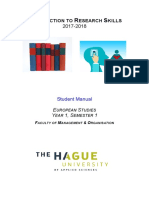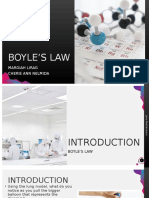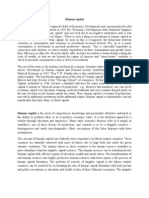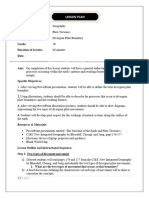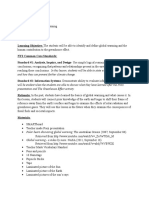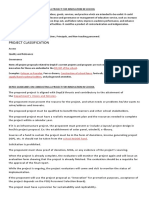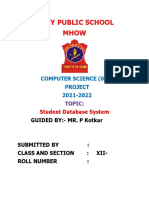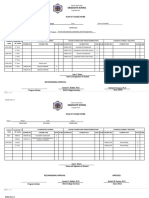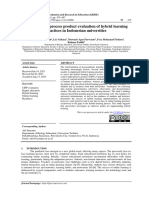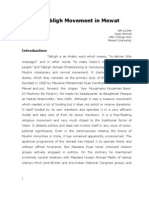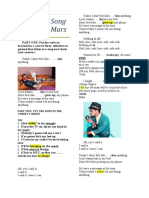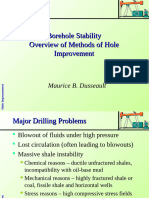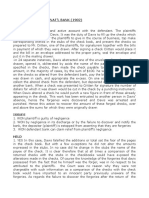Overview of Blended Learning: The Effect of Station Rotation Model On Students' Achievement
Overview of Blended Learning: The Effect of Station Rotation Model On Students' Achievement
Uploaded by
deviCopyright:
Available Formats
Overview of Blended Learning: The Effect of Station Rotation Model On Students' Achievement
Overview of Blended Learning: The Effect of Station Rotation Model On Students' Achievement
Uploaded by
deviOriginal Title
Copyright
Available Formats
Share this document
Did you find this document useful?
Is this content inappropriate?
Copyright:
Available Formats
Overview of Blended Learning: The Effect of Station Rotation Model On Students' Achievement
Overview of Blended Learning: The Effect of Station Rotation Model On Students' Achievement
Uploaded by
deviCopyright:
Available Formats
Journal of Critical Reviews
ISSN- 2394-5125 Vol 7, Issue 6, 2020
Review Article
OVERVIEW OF BLENDED LEARNING: THE EFFECT OF STATION ROTATION MODEL
ON STUDENTS’ ACHIEVEMENT
Nur Fathin Suhana Ayob1*, Noor Dayana Abd Halim2, Nurul Nadwa Zulkifli3, Norasykin Mohd Zaid4,
Mahani Mokhtar5
1*SMK Sultan Ismail Johor Bahru Malaysia. fathinsuhana91@gmail.com
2Department of Educational Sciences, Mathematics, and Creative Multimedia, School of Education, Faculty of Social Sciences
and Humanities, Universiti Teknologi Malaysia. noordayana@utm.my.
3Department of Basic Science and Engineering, Faculty of Agriculture and Food Sciences, Universiti Putra Malaysia (Bintulu
Campus), Malaysia. nurulnadwa@upm.edu.my.
4Department of Educational Sciences, Mathematics, and Creative Multimedia, School of Education, Faculty of Social Sciences
and Humanities, Universiti Teknologi Malaysia. norasykin@utm.my .
5Department of Educational Foundation & Social Sciences, School of Education, Faculty of Social Sciences and Humanities,
Universiti Teknologi Malaysia. p-mahani@utm.my
Received: 05.02.2020 Revised: 12.03.2020 Accepted: 30.04.2020
Abstract
This paper aims to review on blended learning models specifically on station rotation model includes the implementations and
results of past studies on students’ achievement. This paper starts with an overview of blended learning concepts that could be
implemented in teaching and learning and the issue arising in the promoting better understanding of the concepts. The discussion
leads to the potential of using a station rotation model of blended learning for future study as the review from the past studies
revealed that this model had positive impacts on students' achievement. These results are so promising, and this model could be
designed and implemented in future studies
Key words: Blended Learning, Station Rotation Model, Achievement.
© 2019 by Advance Scientific Research. This is an open-access article under the CC BY license (http://creativecommons.org/licenses/by/4.0/)
DOI: http://dx.doi.org/10.31838/jcr.07.06.56
INTRODUCTION
Modern educational technology is a revolution due to the reportedly one of the most effective strategies to implement
widespread reach of the internet along with the information without ignoring the teachers' role in the classroom.
and communication technology (ICT) [1], [2]. ICT stands for Moreover, blended learning also compliments the benefits of
any application which involves the usage of communication both, offline traditional F2F learning and online learning [6],
devices includes radio, television, cellular phone, computer, [8]. Besides, the research by Philips [10] claimed that the
and a variety of related services such as video conferencing students do see some importance in online learning. However,
and online learning [3]. The utilization of ICT makes teaching students did not want online learning to completely replace
more effective and interesting and it also enhances students' offline traditional F2F learning.
learning which can create a modern learning environment [3].
Blended learning is frequently implemented in the education
In this revolution of ICT, teachers should take initiatives to find sector and other sectors such as nursing, the working sector
out innovative ways to fulfil students' learning needs, because and many others outside Malaysia [11]. It is believed that
the education system is always changing. Essentially, the blended learning, if implemented well, is very effective
teachers have to put effort to implement innovative teaching because, a teacher does not hold a passive role, but instead
methods in the classroom [4]. Teachers have to immediately acts as a mentor or a coach who gives personalized
replace the old learning styles such as chalk and talk methods, instructions. Online learning itself cannot solely replace the
in favour of more active learning activities by implementing teacher's role in instructing and teaching students. A
creative teaching approaches. significant part of this approach is the transition of their role
from supplying knowledge to coaching students based on their
Many innovative teaching approaches can be implemented for abilities [12]. Teachers can engage, inspire and empower
example collaborative learning, inquiry-based learning, students to experience learning when they are in smaller
project-based learning, blended learning, and many others. groups within a blended learning environment [12].
From the perspective of ICT, education can be categorized into
three main categories, (1) e-learning, (2) blended learning and BLENDED LEARNING
(3) distance learning (Kumar, 2008). Among them, blended Blended learning is created as an environment which takes the
learning has gained many spotlights in the education sector values of both offline traditional F2F learning and online
[5]. Blended learning is specified as the combination of various learning [13]. It is the new trend in teaching and learning of
instructional media, delivery approaches and different kinds of core subjects including science.
pedagogical approaches [6]. The core of blended learning is
the combination of both, offline traditional face-to-face (F2F) Blended learning is a commonly used method in schools and
learning and online learning [6]–[8]. Blended learning covers universities levels. Teachers already used blended learning in
the weaknesses of both, offline traditional F2F learning and their teaching and learning process. However, the difference is
online learning. It also helps students to study anywhere and the approach to design the learning experience [14]. As
anytime, makes it easier for them to access the learning reported, blended learning has different perceptions for
activities, and increases their interaction and engagement [9]. different people [13], [15]. Some of the researchers mentioned
that the blended learning system combines face-to-face
It is the best move to combine the advantages of offline instruction and computer-mediated learning [8]. In contrast,
traditional F2F learning and online learning in a blended some people argued that the term blended learning is ill-
learning environment [4]. The blended learning approach is defined [13], [16].
Journal of critical reviews 320
OVERVIEW OF BLENDED LEARNING: THE EFFECT OF STATION ROTATION MODEL ON STUDENTS’ ACHIEVEMENT
They stated that the concept of blended learning can lead to researchers such as traditional method, web facilitated
misconceptions as it can be thought of blending in teaching approach and blended or hybrid learning.
only instead of learning. They mentioned that the true
meanings of blended learning include “blended pedagogies”, Other than that, blended learning is stated as an instructional
“blended teaching” and “learning with blended pedagogies”. approach that combines different modes of instructional
While some researchers have defined blended learning as methods, instructional technologies, and delivery methods
follows: such as offline traditional F2F learning and online learning
[15]–[17], [19]. Sometimes, blended learning is regarded as
(i) The combination of instructional media such as hybrid learning [7], [20]. Akkoyunlu and Soylu [19] stated that
audio, streaming video, live virtual classroom, blended learning is a combination of various models of online
videotape, CD ROM and collaborative learning [15], and offline education, teaching techniques, learning resources
[17] and all types of relevant technology.
(ii) The combination of different kinds of pedagogical
approaches such as constructivism, behaviourism Blended learning is defined as a combination of offline
and cognitivism [15]. traditional F2F learning and e-learning. Other than that, Allan
(iii) The combination of offline traditional F2F learning [21] believed that "blended learning is the usage of different
with online learning (delivery method) [6], [15], [18]. internet-based tools including chat rooms, discussion groups,
podcasts, and self-assessment tools to support offline
Many debates are revolving around the exact meaning of traditional F2F learning". These quotations give an insight that
blended learning. However, Bonk & Graham [18] stated that blended learning relates to various combinations of
the most accurate definition which reflects the blended technology in the teaching and learning process, and every so
learning systems is the third definition. They emphasized the often a mixture of technology and classroom-based learning.
crucial role of computer-based technologies in blended This study addresses the issues by giving a landscape of
learning. It is supported by Sloan Consortium where blended blended learning which includes time, place, focus, learning
learning is defined as a combination of face-to-face instruction relationships, different ICTs, types of learner, and learning
and online delivery. As highlighted, blended learning has a context [21]. Figure 1 shows an overview of blended learning.
percentage of 30-79% of the contents delivered online [7].
There are a variety of delivery methods as highlighted by the
Figure 1: Overview of Blended Learning [21]
According to Garrison and Kanuka [6], blended learning is can learn anywhere and anytime. Online learning has some
both effortless and complicated. The researchers considered interesting elements which are, the flexibility in time or place
blended learning as simple because it consists of both and the variety of the way of delivering.
synchronous (face-to-face) and asynchronous (text-based
internet) learning activities. At the same time, it is quite BLENDED LEARNING MODEL
complex and very challenging to implement blended learning. Horn and Staker [22] proposed six models of blended learning
For example, the suitability of the design needs to be which are face-to-face driver, online lab, flex, self-blend,
considered in many contexts and limitless design possibilities. rotation and enriched virtual model. However, they removed
Other than that, Horn and Staker [22], [23] stated that there two from the six blended learning models which are face-to-
are uncertainties in blended learning in terms of the required face and online lab because they believed that these were
expenses and the actual output. Meanwhile, they believed copies of other models. An overview of the models is given in
blended learning is a formal learning approach where students Figure 2 [24]. The explanation for each model is given below:
Figure 2: Categories of Blended Learning [24]
1. Flex model – Contents delivered mostly via an online
platform. Students are flexible to move on their own
Journal of critical reviews 321
OVERVIEW OF BLENDED LEARNING: THE EFFECT OF STATION ROTATION MODEL ON STUDENTS’ ACHIEVEMENT
among the delivery modalities. The teacher will be on 6. Station rotation – Students rotate between different
the side of the students. Individual tutoring and small learning modalities which include one station of online
group sessions will be carried out if needed. learning. Other stations will include a few small groups
2. Self-blend model – The students learn one or more or the whole class. The content includes tasks by groups,
topics using the online platform with an online teacher. individual tutoring and assignments.
It will assist the offline traditional F2F learning. 7. Lab rotation –Students rotate from their classroom to
Students blend themselves by learning online the learning lab to join the lessons.
individually and learning at schools with F2F teacher. 8. Flipped classroom – Students rotate between offline
3. Enriched-virtual model – Students take offline traditional F2F learning at school and the delivery of
traditional F2F learning and learn the content and content via online sources at their home after the school
instructions alone using online learning. They divide the session.
time on their own. In general, it is a normal school 9. Individual Rotation – Students will rotate based on a
experience. fixed individual schedule. The teacher will set their
4. Rotation – Students rotate between different learning student schedules. The students do not need to rotate
methods. They rotate between online learning in offline for every station or method.
traditional F2F classroom and online environments. Meanwhile, Staker and Horn [22] proposed four major
5. Then, they also have to learn in F2F learning classroom. models in the blended learning classroom. The detailed
The rotation model is divided into four small groups. comparison of each of these four major models in the blended
learning classroom is discussed in Table 1 below.
Table 1: Four Major Types of Models in Blended Learning Classroom [23]
Enriched-virtual
Characteristics Rotation model Flex model Self-blend model
Model
Learning online individually
and learning at schools with a
Different from the
F2F teacher.
enriched-virtual
Within a classroom or a set of Students learn mostly at Whole school
Setting model because it is
classrooms [12], [23], [25]. school with a teacher using experience [23].
not a whole-school
offline traditional F2F
experience [23].
learning except for the
homework [25].
Students divide their
The content and instruction Students can choose
Students rotate in a fixed time between offline
are fully delivered via online fully online methods
schedule or according to the traditional F2F
Rotation learning to support their
teachers’ desires [12], [23], learning and content
Backbone of this model is offline traditional
[25]. delivery via remote
online learning [25]. F2F learning [23].
online learning [23].
It usually starts with a
Students rotate among Students rotate individually
Students can take fully online learning
Learning stations. among learning activities and
online learning at method, then becomes
method At least one station is an offline traditional F2F
school or home [23]. a blended learning
online learning station [23]. teachers [23].
method [23].
The stations include direct Offline traditional F2F
instruction from the teacher, teacher will provide activities
small group or whole class if needed – small group,
activities, group projects, group projects and individual Students use online
Students seldom meet
individual tutoring and tutoring [23]. learning for some
F2F with their
assignments [23], [25]. Some have F2F teachers with subjects and use
Activities teachers every school
When the time is up, the the support of online offline traditional
day. It only happens
teacher makes an learning, while some have F2F learning for
when needed [25].
announcement and instructs only a little offline traditional other subjects [25].
the students to rotate and go F2F learning. They have
to the next activity at the next different combinations too
station [25]. [23].
Students will have
Rotations have been used in Some of them have more Students involve
F2F learning with
many years, but what makes offline traditional F2F themselves in both
their teacher and they
Station this blended learning is the learning support, but others online learning and
are free to complete
involvement of online have minimum support for offline traditional
remaining works
learning [12]. the traditional approach [23]. F2F learning [23].
remotely [25].
Based on Table 1, it is clearly stated that all the models should Types of Rotation Models
have at best one station of online learning. The rotation model According to Staker and Horn [23], one of the blended learning
is quite flexible because students rotate to other stations models is the rotation model. Within the rotation model, there
according to the teachers' desires. The stations include are four specific types which are station rotation, lab rotation,
activities in a small group or involving the whole class, flipped classroom model and individual rotation model. Each
projects in groups, individual tutoring and completing specific type of rotation model is a little bit different from
assignments [23], [25], [26]. Verstelle [12] believed that others; however, they are required to have at least one station
teachers have already mastered the act of rotation between which includes an online learning method [23]. The table 2
different kinds of learning activities, but what would make it below summarizes the four specific types of rotation models in
become blended learning is the involvement of online learning. a blended learning classroom.
Journal of critical reviews 322
OVERVIEW OF BLENDED LEARNING: THE EFFECT OF STATION ROTATION MODEL ON STUDENTS’ ACHIEVEMENT
Table 2: Four Specific Types of Rotation Model in a Blended Learning Classroom [27]
Individual rotation
Characteristics Station rotation model Lab rotation model Flipped classroom model
model
Students rotate in a fixed
schedule between offline
traditional F2F learning
Students rotate in a fixed or projects in school and
Students rotate in a fixed Students rotate in a
schedule according to the content delivery using
Setting/ schedule according to fixed schedule among
teachers’ desires within a online learning after
Rotation teachers’ desires among learning activities
classroom or a set of school time
locations in the school [28]. individually [28].
classrooms [25][12], [28] independently [28]. Time
in classes is used to
discuss the concepts
learned [12].
At least one station is The primary delivery of
predominantly an online content and instruction
At least one station is an At least one station is
Learning learning station in a computer from the teacher is
online learning station an online learning
method lab [28]. delivered during online
[28]. station [28]
Students rotate in computer learning outside the
lab for online learning [25]. school [25], [28]
Other stations: small
group or whole class
activities, projects in
groups, individual
Students rotate among Teachers will set
tutoring, online Students need to do
different locations in the student’s schedules
Activities individual learning, homework online at
school instead of rotate in one individually
assignments, night [25], [28].
classroom [28] [25].
independent work at
students' desks, direct
instruction from a
teacher [28]
Example: students
Example: students use
are given a specific
Very similar to station the internet to watch
Students rotate in schedule to rotate
rotation; the lab will be free up online videos for 10-15
Setting different stations in one between online
for other activities within the minutes and complete
classroom [25]. learning and offline
rotation model [12]. questions on Moodle
traditional F2F
[28].
learning [28].
Teachers have been using lab
Students practice and
rotation for many years, but
apply learning in school
Location - the difference is that this -
during offline traditional
model combines it with online
F2F learning [28]
learning [12].
This model is common, but Example: students listen
students need to compete with to teachers outside of the
other students to use the class time and complete
Example - -
computer lab [12]. There is the homework during
also a limit of time to stay in a class time with teachers
computer lab. [12].
It was found out that the lab
rotation model is ideal for Students will not be
teachers who want to use passive learners because
software to access the learning it is more like an activity-
materials or to repeat and based learning method
relearn a specific lesson [12]. [12].
Students rotate through Students do not need
Students rotate out of their Students can control
all stations and not just to rotate every
Differences classrooms to computer labs their own time, place,
the usual routines [25], available station or
to further their understanding path and pace [28]
[28]. modality [25], [28]
of the learning matter [28] Allows the teacher to use
More supervision and careful class time efficiently to
guidance are needed to enhance the
prevent the students from understanding of the
misusing the computer labs topic [12].
[12].
According to the table above, by using the station rotation STATION ROTATION MODEL
model, students can rotate with an unfixed schedule based on From the four specific models above in Table 2, the station
the teachers' desires in a single classroom or a set of rotation model is selected for the review of past studies to
classrooms [25], [28], [29]. It is different from the other conduct a blended learning classroom. It is because the
models because it does not set any usual routines in the classroom can be split into two, three or even four different
classroom. stations based on the needs of the students and teachers [28],
[29]. Meanwhile, the research by Truiit [29] reported that
teachers witnessed an increase of 21% in the performance of
students during the math block lessons using four different
stations of the station rotation model. Their students’ math
Journal of critical reviews 323
OVERVIEW OF BLENDED LEARNING: THE EFFECT OF STATION ROTATION MODEL ON STUDENTS’ ACHIEVEMENT
scores improved significantly. They stated that this learning is enhance the understanding of the topic only. This model
not only effective for a short period of implementation, but it is commonly used in higher education [7], [16], [18], [19], [31],
also sustainable for longer periods. In this research, the station [32]. At last, the individual station rotation model is not
rotation model was selected for further studies. Furthermore, selected due to students rotate with the teacher's schedule
Truiit [29] stated that the major reasons the station rotation individually. Therefore, this paper review on past research to
model was selected are so that the teachers have more examine the results on students' achievement by using a
flexibility to work with their students. For example, a teacher station rotation model.
can break the classes into different sizes of groups, give them
collaborative assignments or distribute independent work to Research on Blended Learning Classroom using Station
every student [28], [29]. Rotation Model towards Learning Achievement
As reported, there is no best model to follow [16]. However, Station rotation is a simple model that allows teachers to have
different models may produce different learning experiences more time with individual students. A rotation model is where
among students. It is supported by [30], there is no single best students rotate between learning stations in or outside the
model to achieve success. They said there is no "one size fits classroom. A few characteristics of station rotation models are
all" approach to make sure the learning successful neither fast explained by researchers. First, a classroom is divided into
result nor the slow result, continuous effort or takes several different stations to allow students to rotate between them.
years. The other models are not selected in this review for Second, the teacher sets the rotation schedule and sits at one
further studies due to some reasons, for example, lab rotation station to give direct instructions. Third, each station consists
model is not used because it is ideal for teachers who want to of different activities even though it has the same learning
use software to access the learning, more supervision and objective. The task in the stations can be done individually, in
guidance needed to prevent the misusing the computer labs, groups or with the teacher. Lastly, there is at least one station
and students need to compete with other students to use the which adopts the online learning approach. Blended learning
computer lab. Then, the flipped classroom model is not can be applied to all the subjects, especially chemistry
selected because this model needs extra time for students to subjects, or science-related subjects for that matter. There are
do some preparation outside the classroom or after and before many reports on the benefits of blended learning. Table 3
the class session [25], [28]. Thus, by implementing this type of shows the review for the designs of blended learning
model, it allows the teacher to use the class time efficiently to classrooms using the station rotation model.
Table 3: Review of Blended Learning Classroom using Station Rotation Model Towards Learning Achievement
Author Objectives Sample Findings
112 students :
Study the effects of blended
experimental group (n = Blended learning had a positive effect on the science test
Alsahi [33] learning on ninth-grade students'
61) and a control group (n scores of intermediate school students.
achievement in science
= 51)
Investigate the achievement of
26 students of the second-
Isti’anah students after implementing Blended learning had a positive effect on the Grammar
semester students from
[34] blended learning in an English test scores
English Department
grammar class
Significant effect shown for experimental group
Study the effect of blended (learning via blended learning method) compared to
34 3rd and
learning on students control group (implemented offline F2F method)
Oweis [35] 4th year students majoring
’achievement and motivation to There was statistically significant impact (α = 0.05) on
in German-English
learn English students’ motivation in experimental group (mean =
1.938) compared to control group (mean = 1.835).
Explore the experiences of Finding proposed five positive themes; technology,
Truitt & Ku 31 elementary students in
learning in Station Rotation learning, variety of activities, getting help, and fun and
[26] a third-grade classroom
model two negative themes; technology and challenging work.
The average of learning outcomes in the experimental
Determine the effect of the 31 students in the
group was 57.8 for pre-test and 82.5 for post-test
blended learning model on senior experimental group and 32
Utami [36] Result shows the students in the experimental group had
high school students' students in the control
higher levels of learning achievement than the control
achievement group
group
Students able to interact with the teacher and friends.
Students experiences increase when involves in various
Investigate effect of station activities at a different station.
Govindaraj 150 college students for
rotation classroom activities Only 11% of students disagreed this learning helps them
[37] Physics subject
towards students’ learning. to learn better due to some factors. Two reasons are the
activities were either too long or too short and
insufficient time to complete the task and in rush.
Investigate the effects of blended Significant effect shown in students' academic
learning on academic 53 students in 6th-grade achievement for the experimental group.
Ceylan [38]
achievement of middle school classrooms in Turkey Experimental group's test scores are greater than the
students'. control group's test scores.
Investigate the students 108 male and female Lack of a statistically significant difference due to the
Khader [39] achievement between two students (3rd grade interaction between the teaching method and the gender
different teaching method. Science) of students.
The test scores on the Pennsylvania System of School
Assessment (PSSA) have increased for all grades and
subjects of the blended learning program.
Case study: Spring city
Apply station rotation model for Comparison of subjects between offline traditional F2F
elementary hybrid
all core subjects learning and blended learning ;
Powell et al. learning school
Reading : 63.9 % (offline) to 82.9 % (blended learning)
[25]
Math : 61.4 % (offline) to 85.4 % (blended learning)
Science : 63.0 % (offline) to 90.0 % (blended learning)
Apply the station rotation model Case study: blended The station rotation model has been effective in
to improve math and English learning in Randolph improving math scores on state assessments.
language (ELA) central school district It shows positive improvement among students.
Eddeen et Evaluate the effectiveness 427 students from King Blended learning had a positive impact on academic
al. [40] of blended learning on the Abdulla II School for achievement of the students.
Journal of critical reviews 324
OVERVIEW OF BLENDED LEARNING: THE EFFECT OF STATION ROTATION MODEL ON STUDENTS’ ACHIEVEMENT
academic achievement of Information Technology at
students Jordan University
Two Year 11 classes. No significant difference observed
Investigate the impact of blended
Smith [41] Control group (n = 11) and However, students who learned via blended learning
learning and F2F learning in K-12
experimental group (n = (experimental class ) rated their levels of learning more
school in Auckland, New Zealand.
19) highly than those in the traditional class
Based on the analysis above, the station rotation model is used 9. R. Francis and S. J. Shannon, “Engaging with blended
for all students in schools [25], [26], [33], [36], [38], [39], [41] learning to improve students’ learning outcomes,” Eur. J.
and university level [11], [34], [35], [37], [40]. Interestingly, Eng. Educ., vol. 38, no. 4, pp. 359–369, 2013.
Powell and friends [25] implemented this model of blended 10. J.A. Phillips, “Replacing traditional live lectures with
learning for all core subjects for all grades in Spring city online learning modules: Effects on learning and student
elementary hybrid learning school. The studies compared the perceptions,” Curr. Pharm. Teach. Learn., vol. 7, no. 6, pp.
subjects between traditional F2F learning and blended 738–744, 2015.
learning, and it was found that the test scores on the 11. A. Salajegheh, A. Jahangiri, E. Dolan-Evans, and S.
Pennsylvania System of School Assessment (PSSA) have Pakneshan, “A combination of traditional learning and e-
increased for all grades and subjects of the blended learning learning can be more effective on radiological
program. This shows the very positive impact of this model to interpretation skills in medical students: a pre-and post-
improve students' achievement in core subjects. It is believed intervention study,” BMC Med. Educ., vol. 16, no. 1, p. 46,
that the station rotation model used in blended learning 2016.
classrooms is effective and will receive good perceptions in the 12. M. Verstelle, “Blended Learning,” Univ. Leiden, 2017, doi:
teaching and learning process [42], [43]. 10.1007/978-3-8349-9318-2_11.
Additionally, many researchers reported that blended learning 13. M. Oliver and K. Trigwell, “Can ‘blended learning’ be
had a positive effect on learning and the mean score of post- redeemed?,” E-Learning, vol. 2, no. 1, pp. 17–26, 2005.
test assessment was higher than pre-test assessment [11], 14. D.R. Garrison and N. D. Vaughan, “Institutional change
[33], [36]. A possible reason is that various activities at the and leadership associated with blended learning
different station could enhance learning experience [37] thus innovation: Two case studies,” internet High. Educ., vol.
leading to the improvement of students' score. Another 18, pp. 24–28, 2013.
possible reason is that the student could have a high cognitive 15. M. Driscoll, “Blended learning: Let’s get beyond the hype,”
level because they can get direct feedback from the teacher E-learning, p. 54, 2002.
when learning using this model. 16. Y.C. Kuo, B.R. Belland, K.E.E. Schroder, and A.E. Walker,
“K-12 teachers’ perceptions of and their satisfaction with
CONCLUSION interaction type in blended learning environments,”
In this paper, a few blended learning models are discussed. Distance Educ., vol. 35, no. 3, pp. 360–381, 2014.
This paper further discussed the rotation model of blended 17. J. Bersin, The blended learning book: Best practices,
learning. Generally, all the rotation models should have at least proven methodologies, and lessons learned. John Wiley &
one station of online learning. The rotation model is quite Sons, 2004.
flexible because students rotate to other stations according to 18. C. Bonk and C. Graham, “Handbook of blended learning
the teachers’ desires. For future study, the station rotation environments,” San Fr. Pfeiffer, 2006.
model is considered to be designed in blended learning. This 19. B. Akkoyunlu and M. Yılmaz-Soylu, “Development of a
paper also reported the past studies that used the station scale on learners’ views on blended learning and its
rotation model in teaching and learning in schools and implementation process,” Internet High. Educ., vol. 11,
universities levels. This model had a positive impact on no. 1, pp. 26–32, 2008.
students’ achievement. 20. H.J. So and T. a. Brush, “Student perceptions of
collaborative learning, social presence and satisfaction in
REFERENCES a blended learning environment: Relationships and
1. Awadh A.Y.Al-Qahtani and S. E. Higgins, “Effects of critical factors,” Comput. Educ., vol. 51, no. 1, pp. 318–
traditional, blended and e-learning on students’ 336, 2008.
achievement in higher education,” J. Comput. Assist. 21. B. Allan, Blended learning: Tools for teaching and
Learn., vol. 29, no. 3, pp. 220–234, 2013. training. Facet Publishing, 2007.
2. M.Á. González et al., “Teaching and Learning Physics with 22. M.B. Horn and H. Staker, “The rise of K-12 blended
Smartphones,” J. Cases Inf. Technol., vol. 17, no. 1, pp. 31– learning,” Innosight Inst., vol. 5, 2011.
50, 2015. 23. H. Staker and M.B. Horn, “Classifying K-12 blended
3. R. Kumar, “Convergence of ICT and Education,” World learning.,” Innosight Inst., 2012.
Acad. Sci. Eng. Technol., vol. 40, no. 2008, pp. 556–559, 24. E. Mohamed Amin, M.N. Norazah, and P. Ebrahim,
2008. Blended and Flipped Learning : Case Studies in Malaysian
4. F.Z. Azizan, “Blended learning in higher education HEIs. 2014.
institution in Malaysia,” in Proceedings of regional 25. A. Powell et al., “Blending learning: The evolution of
conference on knowledge integration in ICT, 2010, vol. online and face-to-face education from 2008 – 2015,” Ina.
10, pp. 454–466. Int. Assoc. K-12 Online Learn., no. July, pp. 1–19, 2015.
5. L. Siew-Eng and M. A. Muuk, “Blended learning in 26. A.A. Truitt and H.Y. Ku, "A case study of third-grade
teaching secondary schools’ English: A preparation for students' perceptions of the station rotation blended
tertiary science education in Malaysia,” Procedia-Social learning model in the United States," EMI. Educ. Media
Behav. Sci., vol. 167, pp. 293–300, 2015. Int., vol. 55, no. 2, pp. 153–169, 2018.
6. Garrison and Kanuka, “Blended learning: Uncovering its 27. Mohamed Amin Embi., Blended & flipped learning :
transformative potential in higher education,” Internet case studies in Malaysian HEIs. 2014.
High. Educ., vol. 7, no. 2, pp. 95–105, 2004. 28. H. Staker and M. B. Horn, “Classifying K – 12 blended
7. I.E. Allen, J. Seaman, and R. Garrett, Blending in: The learning,” Innosight Inst., no. May, p. 22, 2012.
extent and promise of blended education in the United 29. A. A. Truitt, "A case study of the Station Rotation blended
States. ERIC, 2007. learning model in a third-grade classroom," 2016.
8. A.M. Bliuc, R. Ellis, P. Goodyear, and L. Piggott, “Learning 30. P. Moskal, C. Dziuban, and J. Hartman, “Blended learning:
through face-to-face and online discussions: Associations A dangerous idea?,” Internet High. Educ., vol. 18, pp. 15–
between students’ conceptions, approaches and academic 23, 2013.
performance in political science,” Br. J. Educ. Technol., 31. Z. Akyol, N. Vaughan, and D. R. Garrison, “The impact of
vol. 41, no. 3, pp. 512–524, 2010. course duration on the development of a community of
Journal of critical reviews 325
OVERVIEW OF BLENDED LEARNING: THE EFFECT OF STATION ROTATION MODEL ON STUDENTS’ ACHIEVEMENT
inquiry,” Interact. Learn. Environ., vol. 19, no. 3, pp. 231–
246, 2011.
32. M.A. Embi, N.M. Nordin, and E. Panah, “Blended learning
readiness in Malaysia,” Blended Flip. Learn. Case Stud.
Malaysian HEIs, pp. 37–55, 2014.
33. N.R. Alsalhi, M.E. Eltahir, and S.S. Al-Qatawneh, "The
effect of blended learning on the achievement of ninth-
grade students in science and their attitudes towards its
use," Heliyon, vol. 5, no. 9, p. e02424, 2019.
34. A. Isti’anah, “The effect of blended learning to the
students’ achievement in grammar class,” IJEE
(Indonesian J. English Educ., vol. 4, no. 1, pp. 16–30, 2017.
35. T.I. Oweis, “Effects of using a blended learning method on
students’ achievement and motivation to learn English in
Jordan: A Pilot Case Study,” Educ. Res. Int., vol. 2018,
2018.
36. I.S. Utami, “The effect of blended learning model on
senior high school students’ achievement,” in SHS Web of
Conferences, 2018, vol. 42, p. 27.
37. A. Govindaraj and V. S. G. Silverajah, “Blending Flipped
Classroom and Station Rotation Models in Enhancing
Students’ Learning of Physics,” in Proceedings of the
2017 9th International Conference on Education
Technology and Computers, 2017, pp. 73–78.
38. V.K. Ceylan and A.E. Kesici, “Effect of blended learning to
academic achievement,” J. Hum. Sci., vol. 14, no. 1, pp.
308–320, 2017.
39. N.S.K. Khader, “The Effectiveness of Blended Learning in
Improving Students’ Achievement in Third Grade’s
Science in Bani Kenana.,” J. Educ. Pract., vol. 7, no. 35, pp.
109–116, 2016.
40. L.N. Eddeen, O. Harfoushi, and N. Alassaf, “Effect of
Blended-Learning on Academic Achievement of Students
in the University of Jordan,” no. March 2015, 2014.
41. N.V Smith, “Face-to-face vs . blended learning : Effects on
secondary students ‘ perceptions and performance,”
Procedia - Soc. Behav. Sci., vol. 89, pp. 79–83, 2013.
42. G.A.Y.P. Adistana and W. D. Dwiyogo, “The Influence of
Blended Learning Station-Rotation (Cooperative Vs
Competitive) and Cognitive Style Towards Intellectual
Skill in Management,” Int. J. Manag. Adm. Sci., vol. 3, no.
05, pp. 3–9, 2014.
43. A.A. Truitt, "A case study of the Station Rotation blended
learning model in a third-grade classroom," ProQuest
Diss. Theses, p. 273, 2016.
Journal of critical reviews 326
You might also like
- OPT B2 U11 Grammar HigherDocument1 pageOPT B2 U11 Grammar HigherMagasho LocoshonNo ratings yet
- Inquiry-Based Science Lesson PlanDocument11 pagesInquiry-Based Science Lesson Planapi-317561166No ratings yet
- Provide Students With Some Basic InformationDocument14 pagesProvide Students With Some Basic InformationHafeez BuzdarNo ratings yet
- Teaching PLC Chap1Document38 pagesTeaching PLC Chap1mhafizanNo ratings yet
- Anecdotal RecordDocument3 pagesAnecdotal Recordapi-526898274No ratings yet
- Lesson Plan PowerpointDocument13 pagesLesson Plan Powerpointapi-516499111No ratings yet
- Balanced and Unbalanced ForcesDocument31 pagesBalanced and Unbalanced ForcesInah MasubayNo ratings yet
- Program Evaluation and ManagementDocument28 pagesProgram Evaluation and ManagementJenny Katherine L. HensonNo ratings yet
- Creative Technologies 10 Quarter 3 ReviewerDocument8 pagesCreative Technologies 10 Quarter 3 ReviewerjuswikNo ratings yet
- Intro To Research Student Manual 2017-2018Document82 pagesIntro To Research Student Manual 2017-2018Teddy Les HolladayzNo ratings yet
- Boyle'S Law: Margiah Lirag Cherie Ann NelmidaDocument18 pagesBoyle'S Law: Margiah Lirag Cherie Ann NelmidaCHERIE KWONNo ratings yet
- Lecture 4-Capacitive CircuitsDocument38 pagesLecture 4-Capacitive CircuitsBen MachariaNo ratings yet
- Lec5 Robot SensorsDocument6 pagesLec5 Robot SensorsIsuru Pasan DasanayakeNo ratings yet
- Quantitative Research (Hypothesis)Document11 pagesQuantitative Research (Hypothesis)Journey FirjaNo ratings yet
- Letter of Request To Conduct StudyDocument1 pageLetter of Request To Conduct StudyMaria Angelica MartinezNo ratings yet
- Human CapitalDocument4 pagesHuman CapitalKumar DayanidhiNo ratings yet
- Project - Based Learning Strategies in Scienceand Metacognitive Skills Among Grade 5 PupilsDocument11 pagesProject - Based Learning Strategies in Scienceand Metacognitive Skills Among Grade 5 PupilsAPJAET JournalNo ratings yet
- Carbon CompoundsDocument30 pagesCarbon CompoundsMimie Yasmin KamalNo ratings yet
- Robotics in EducationDocument1 pageRobotics in Educationpalji palNo ratings yet
- Divergent Plate Boundary Lesson PlanDocument4 pagesDivergent Plate Boundary Lesson PlanShavelle GrandisonNo ratings yet
- Project Proposal GulayanDocument4 pagesProject Proposal GulayanChristine100% (1)
- OIE 751 ROBOTICS Unit 3 Class 5 (19-9-2020)Document14 pagesOIE 751 ROBOTICS Unit 3 Class 5 (19-9-2020)MICHEL RAJ100% (1)
- Activity Boyle's LawDocument1 pageActivity Boyle's LawmikaNo ratings yet
- Hypothesis Development and TestingDocument7 pagesHypothesis Development and TestingDany Tri KrismawantiNo ratings yet
- Open Ended LaboratoryDocument6 pagesOpen Ended LaboratoryDede MisbahudinNo ratings yet
- Parts of The Science Investigatory ProjectDocument4 pagesParts of The Science Investigatory ProjectNeslierae MonisNo ratings yet
- Global Warming Lesson PlanDocument4 pagesGlobal Warming Lesson Planapi-313105261No ratings yet
- Simple Harmonic Motion Unit Plan 2014-03-26Document3 pagesSimple Harmonic Motion Unit Plan 2014-03-26sk112No ratings yet
- Who Will Innovate?: Department's Vision and MissionDocument3 pagesWho Will Innovate?: Department's Vision and MissionEybisidee CoNo ratings yet
- Rationale of The SIM-geneticsDocument15 pagesRationale of The SIM-geneticsglemarNo ratings yet
- Action Research in Science Education ERIC DigestDocument5 pagesAction Research in Science Education ERIC DigestsahinceNo ratings yet
- Innovation in Teaching and Learning InstrumentationDocument28 pagesInnovation in Teaching and Learning InstrumentationumashankaryaligarNo ratings yet
- Project Starr Ballad, Amy Innovation 2021Document9 pagesProject Starr Ballad, Amy Innovation 2021Jefferson BalladNo ratings yet
- Research Proposal Community Needs Teachers Research JOPETDocument5 pagesResearch Proposal Community Needs Teachers Research JOPETMark DipadNo ratings yet
- Effects of Result-Based Capability Building Program On The Research Competency, Quality and Productivity of Public High School TeachersDocument11 pagesEffects of Result-Based Capability Building Program On The Research Competency, Quality and Productivity of Public High School TeachersGlobal Research and Development ServicesNo ratings yet
- Writing The Review of Related Literature and Studies PDFDocument38 pagesWriting The Review of Related Literature and Studies PDFAllianie EspejoNo ratings yet
- Blended Learning PHDocument11 pagesBlended Learning PHVictor Belamide SisonNo ratings yet
- DLL Convection CurrentDocument13 pagesDLL Convection CurrentHeidie BalabboNo ratings yet
- Balmeo - Open High School Program-Its Effects and Implications On The Socio-Emotional Development Of%Document22 pagesBalmeo - Open High School Program-Its Effects and Implications On The Socio-Emotional Development Of%Gail EdrosoNo ratings yet
- KUD Chart - Know Understand DoDocument4 pagesKUD Chart - Know Understand DoArjess ValenciaNo ratings yet
- Beginning A Stem Research ProjectDocument13 pagesBeginning A Stem Research ProjectKahlil CayonNo ratings yet
- Science Investigatory ProjectDocument4 pagesScience Investigatory Projectmaine rase100% (1)
- 8.1 3is Gathering of DataDocument15 pages8.1 3is Gathering of DataIkang CabreraNo ratings yet
- Science and TechnologyDocument18 pagesScience and TechnologyMia Grace BautistaNo ratings yet
- GST LectureDocument45 pagesGST LectureJojoi N JecahNo ratings yet
- Inquiries Investigation and Immersion Lesson 1 CompleteDocument18 pagesInquiries Investigation and Immersion Lesson 1 CompleteKent Nicole PadingNo ratings yet
- CHAPTER I CompilationDocument11 pagesCHAPTER I CompilationSoraim HadjinorNo ratings yet
- Capstone Module 1 LITERATURE REVIEWDocument3 pagesCapstone Module 1 LITERATURE REVIEWJessica AngayenNo ratings yet
- Electric Potential Energy and Electric Potential: Department of Physics University of Engineering & Technology, LahoreDocument33 pagesElectric Potential Energy and Electric Potential: Department of Physics University of Engineering & Technology, LahoreAbubakar BalochNo ratings yet
- DLP DemoDocument6 pagesDLP DemoMohammad khalidNo ratings yet
- Four Ways To Differentiate InstructionDocument2 pagesFour Ways To Differentiate Instructionjleishma15No ratings yet
- Model Project Synopsis For Computer Science ProjectDocument6 pagesModel Project Synopsis For Computer Science ProjectAman Kumar ChouhanNo ratings yet
- Action Research 2019 MatrixDocument3 pagesAction Research 2019 MatrixSandra Neri JacalneNo ratings yet
- January 132022 LAC Session NarrativeDocument3 pagesJanuary 132022 LAC Session NarrativeMcville QuiranteNo ratings yet
- BU-F-GS-5 SAMPLE - Fillable BUGS Plan of Coursework - MS WordDocument3 pagesBU-F-GS-5 SAMPLE - Fillable BUGS Plan of Coursework - MS WordRhum BayNo ratings yet
- Administration and Supervision of Extra Curricular Activities Copies For ClassmatesDocument3 pagesAdministration and Supervision of Extra Curricular Activities Copies For Classmatesmaricel l. pasagNo ratings yet
- DLP Impulse ContexDocument5 pagesDLP Impulse Contexariane.mirandaNo ratings yet
- Unit 1.8 Planets and StarsDocument14 pagesUnit 1.8 Planets and StarsSze WeiNo ratings yet
- COT Lesson Plan Science 9Document17 pagesCOT Lesson Plan Science 9jessa diezNo ratings yet
- ACTION RESEARCH Final Na UntaDocument9 pagesACTION RESEARCH Final Na UntaWilliam VincentNo ratings yet
- 2 PBDocument13 pages2 PBlingkar pena indonesiaNo ratings yet
- Grade 11 Revision QuestionsDocument12 pagesGrade 11 Revision QuestionsSaheed AbdulkarimNo ratings yet
- IEEE Standard Definitions For Use in Reporting Electric Generating Unit Reliability, Availability, and ProductivityDocument30 pagesIEEE Standard Definitions For Use in Reporting Electric Generating Unit Reliability, Availability, and Productivitycantorband8234100% (1)
- Smog Check Inspection Procedures Visible Smoke TestDocument4 pagesSmog Check Inspection Procedures Visible Smoke TestmarcosperesNo ratings yet
- MethaneDocument22 pagesMethaneAssassin's j :uNo ratings yet
- (Kunci) Soal Sas Genap Bahasa Inggris Kelas Xi 2024Document6 pages(Kunci) Soal Sas Genap Bahasa Inggris Kelas Xi 2024khayrunaa3No ratings yet
- Tabligh Movement in Mewat - Dr. Aijaz Ahmad, Associate Professor, YMD College, Nuh, MewatDocument11 pagesTabligh Movement in Mewat - Dr. Aijaz Ahmad, Associate Professor, YMD College, Nuh, MewatAijaz AhmadNo ratings yet
- The Lazy Song by Bruno Mars: Part Two: Put The Lines in The Correct OrderDocument2 pagesThe Lazy Song by Bruno Mars: Part Two: Put The Lines in The Correct Orderneila starNo ratings yet
- TESDA DirectoryDocument8 pagesTESDA DirectoryThemis143No ratings yet
- Borehole StabilityDocument73 pagesBorehole StabilitymuditmmittalNo ratings yet
- (Click) : Physics MCQ Discussions - by Sandun K. DissanayakaDocument1 page(Click) : Physics MCQ Discussions - by Sandun K. DissanayakatharindadezoysaNo ratings yet
- FURUNO 完整题库Document21 pagesFURUNO 完整题库luojiansong1008No ratings yet
- Homework Contract For Middle School StudentsDocument7 pagesHomework Contract For Middle School Studentsqppipsfng100% (1)
- Gourami (Osphronemus Goramy) : Ecological Risk Screening SummaryDocument17 pagesGourami (Osphronemus Goramy) : Ecological Risk Screening SummaryFANOMEZANTSOA Nantenaina PatrickNo ratings yet
- JY1Y9Z.final JBVNL Cost Data Book 2022-23Document219 pagesJY1Y9Z.final JBVNL Cost Data Book 2022-23Sahil MohammedNo ratings yet
- Extra-Judicial Settlement CaselesDocument6 pagesExtra-Judicial Settlement CaselesRoy PersonalNo ratings yet
- Case StudyDocument9 pagesCase StudyKaushal AgrawalNo ratings yet
- Multitasking Operation SYSTEM - 2023EV149: Dharsan S (201CS146)Document8 pagesMultitasking Operation SYSTEM - 2023EV149: Dharsan S (201CS146)BHUVANESH SNo ratings yet
- Irigaray Women On The MarketDocument11 pagesIrigaray Women On The MarketRed Army 97No ratings yet
- ITRS More Than Moore PDFDocument31 pagesITRS More Than Moore PDFSiddhanta RoyNo ratings yet
- Qutb-Ud-Din Aibak (Arabic:: Ud-Dîn Raziyâ, Usually Referred To in History As Razia SultanDocument8 pagesQutb-Ud-Din Aibak (Arabic:: Ud-Dîn Raziyâ, Usually Referred To in History As Razia SultanTapash SunjunuNo ratings yet
- Iec TR 61491-2010Document22 pagesIec TR 61491-2010hertorNo ratings yet
- Critten V Chemical Nat'l Bank (1902)Document2 pagesCritten V Chemical Nat'l Bank (1902)Diane Dee YaneeNo ratings yet
- Vmware Vcap-Dca Cli Cheat Sheet v1.0Document18 pagesVmware Vcap-Dca Cli Cheat Sheet v1.0Shamika Vishal MulikNo ratings yet
- AcapellaDocument3 pagesAcapellaashsoniNo ratings yet
- Elementary 2. Pre-Intermediate / Intermediate 3. Upper-Intermediate 4. AnvencedDocument7 pagesElementary 2. Pre-Intermediate / Intermediate 3. Upper-Intermediate 4. AnvencedNo NameNo ratings yet
- Sexual Reproduction in Flowering PlantDocument5 pagesSexual Reproduction in Flowering PlantInfinite SinghNo ratings yet
- De La Umor Referential La Umor Esuat PDFDocument14 pagesDe La Umor Referential La Umor Esuat PDFfroggy114No ratings yet
- Your Transformation: The 10 Principles of TransformationDocument1 pageYour Transformation: The 10 Principles of TransformationSheila EnglishNo ratings yet
- Realty World Alliance A Great Investment Opportunity: Denise GrayDocument8 pagesRealty World Alliance A Great Investment Opportunity: Denise GrayDenise GrayNo ratings yet









